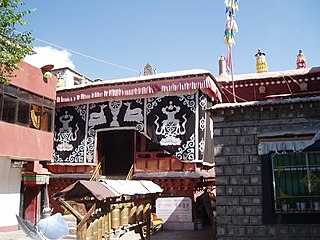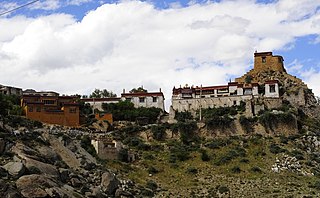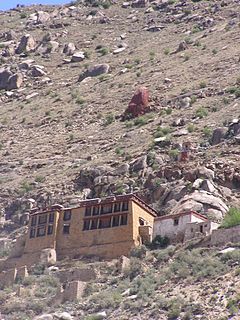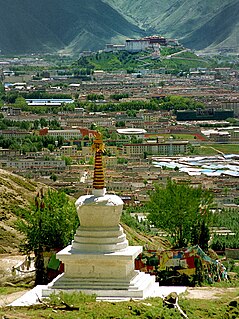
Sonam Gyatso was the first to be named Dalai Lama, although the title was retrospectively given to his two predecessors.
Ngawang Lobzang Jampel Tsultrim Gyatso or Tsultrim Gyatso was the 10th Dalai Lama of Tibet, and born in Chamdo. He was fully ordained in the Gelug school of Tibetan Buddhism, studied the sutras and tantras, had several students, and rebuilt the Potala Palace.

Gedun Gyatso, also Gendun Gyatso Palzangpo, was considered posthumously to be the second Dalai Lama.

Sera Monastery is one of the "great three" Gelug university monasteries of Tibet, located 1.25 miles (2.01 km) north of Lhasa and about 5 km (3.1 mi) north of the Jokhang. The other two are Ganden Monastery and Drepung Monastery. The origin of its name is attributed to a fact that during construction, the hill behind the monastery was covered with blooming wild roses.

Drepung Monastery, located at the foot of Mount Gephel, is one of the "great three" Gelug university gompas (monasteries) of Tibet. The other two are Ganden Monastery and Sera Monastery.
Mahāyoga is the designation of the first of the three Inner Tantras according to the ninefold division of practice used by the Nyingma school of Tibetan Buddhism.

Kumbum Monastery, also called Ta'er Temple, is a Tibetan gompa in Lusar, Huangzhong County, Xining, Qinghai, China. It was founded in 1583 in a narrow valley close to the village of Lusar in the historical Tibetan region of Amdo. Its superior monastery is Drepung Monastery, immediately to the west of Lhasa. It is ranked in importance as second only to Lhasa.

Ngamring County is a county of Xigazê in the Tibet Autonomous Region. "Ngamring County, sometimes referred to as the gateway to Mount Kailash and Far West Tibet, is the barren area which divides the Raga Tsangpo and the Brahmaputra."

Trode Khangsar is a temple located in Lhasa, Tibet Autonomous Region, China, that is over 300 years old. The temple is dedicated to the protector Dorje Shugden and has been traditionally managed by the Gelug monastery Riwo Chöling, which is located in the Yarlung valley.
Trülku Drakpa Gyeltsen (1619–1656) was an important Gelugpa lama and a contemporary of the 5th Dalai Lama (1617–1682). His Seat was the upper residence of Drepung Monastery, a famous Gelug gompa located near Lhasa.
The Changkya Khutukhtu was the title held by the spiritual head of the Gelug lineage of Tibetan Buddhism in Inner Mongolia during the Qing dynasty.

Keutsang Hermitage is a historical hermitage, belonging to the Sera Monastery, about 8 kilometres (26,000 ft) northwest of Lhasa in Tibet Autonomous Region. The hermitage was in a precariously perched cave once inhabited by the great Tibetan guru Tsongkhapa. However, the original cave collapsed in a landslide. What is present now was rebuilt, adjoining the ruined Keutsang West Hermitage, at a safer location. As it exists now, Keutsang is to the east of Sera on a hillside above Lhasa’s principal cemetery. Rakhadrak Hermitage is above and close to this hermitage.

Purbuchok Hermitage is a hermitage situated in the northeastern corner of the Lhasa Valley in the northern suburb of Dodé in the Tibet Autonomous Region of the People's Republic of China. Destroyed by the Chinese in 1959, it was mostly restored in 1984. Affiliated to the Sera Monastery, it is the last hermitage to be visited on the “Sixth-Month Fourth-Day” pilgrimage circuit. The hills surrounding the monastery have been given name tags of the three protectors of the divine paradise namely the Avalokiteśvara, Manjusri and Vajrapani. It is also identified with the six-syllables divine mantra (sngags)- OM Mani Padme Hum.

Sera Chöding Hermitage, affiliated with Sera Monastery, is situated in Lhasa prefecture of Tibetan Autonomous Region of the People's Republic of China. It is located close to the Sera Monastery and faces south. The hermitage has a yellow house, which was originally built by the Tibetan Guru Tsongkhapa who spent many years there, spread over several occasions. It was his favourite meditating place and he wrote his great work, the “Great Commentary on the Prajñāmūla, while in residence. He also taught there. It is also known as the hermitage where Tsongkhapa entrusted his Tantric teachings to Rje shes rab seng ge (1383–1445), the founder of the Tantric Colleges.

Sera Utsé Hermitage, Sera Utse, Sera Ütse, Sera Tse or Drubkjang Tse is a historical hermitage, belonging to Sera Monastery. It is located on the mountain directly behind Sera Monastery itself, which is about 5 kilometres (3.1 mi) north of the Jokhang in Lhasa, Tibet Autonomous Region of the People's Republic of China. It is older than Sera Monastery.

Chupzang Nunnery(Chu bzang dgon) is a historical nunnery, belonging to Sera Monastery. It is located north of Lhasa in Tibet, China. Though the site was established as a hermitage around 1665, it was converted into an exclusive nunnery in 1984 and has since grown into one of the largest nunneries in the Lhasa Valley.

Garu Nunnery is a historical hermitage, belonging to Sera Monastery. It is located north of Lhasa, Lhasa Prefecture, in the Tibet region of China. The nunnery has an ancient history traced to Padmasambhava, the Indian Buddhist preceptor, who visited this location. He not only named the place as "Garu" but also ordained that it shall be a "Nunnery" not a monastery of monks on the basis of prophetic visions he had during his visit to the place. In the late 1980s and early 1990s, some nuns from the monasteries have made publicized demonstrations for Tibetan independence. Many of the protesting nuns were arrested, incarcerated, brutally handled and released only after protracted detention.

Negodong Nunnery is a historical hermitage, belonging to Sera Monastery. It is located in the northeastern Lhasa suburb known as Dodé Valley, northeast of Sera, Tibet. Buddhist scholar of the Sera Jé College’s Gomdé Regional House, Nam mkha’ rgyal mtshan. It was initially founded as a monastery with seventeen monks but later allotted for exclusive use as nunnery to provide personal security to the nuns who were then residing in a remote nunnery at Gnas nang, away from the present location at Gnas sgo gdong.

Nénang Monastery is a historical gompa for Buddhist monks and nuns belonging to Sera Monastery. It is located west of Lhasa in Doilungdêqên County in Tibet Autonomous Region.

Pawo Tsuglag Threngwa, the second Nenang Pawo, was a Tibetan historian of the Karma Kagyu. He was a disciple of Mikyö Dorje, 8th Karmapa Lama. He was the author of the famous mkhas pa'i dga' ston, A Scholar's Feast, addressing history of Buddhism in India and its spread in Tibet, as well as the history of Tibet.
Of Tsuklak Trengwa's many students, his chief disciples included the Ninth Karmapa Wangchuk Dorje, the Fifth Zhamar Konchok Yenlag, and the Third Tsurpu Gyeltsab, Drakpa Peljor.




















